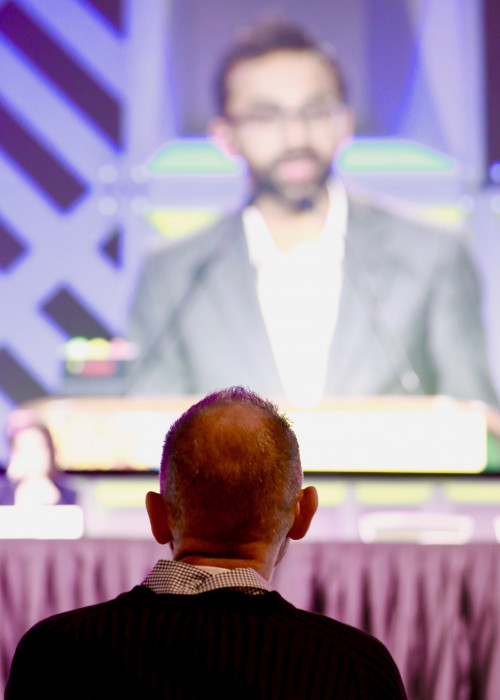A Brazilian man diagnosed with HIV in 2012 has maintained a fully suppressed viral load for over a year after receiving a yearlong intensified treatment regimen and then discontinuing his antiretrovirals (ARVs). Researchers have indicated that if sufficient time passes without the man’s viral load rebounding, he could become the first person officially cured of HIV without receiving a bone marrow transplant.
Ricardo Sobhie Diaz, MD, PhD, of Federal University of São Paulo, presented findings from the case study on Tuesday at the International AIDS Conference (AIDS 2020), which is being held virtually this week.
The 35-year-old Brazilian man is one of 30 members of a study of an intensified treatment regimen in which the ARVs Tivicay (dolutegravir) and Selzentry (maraviroc) were added to participants’ existing HIV regimens, along with the drug nicotinamide. The latter drug inhibits the exhaustion of the immune system and prevents cells from entering a latent, or non-reproducing, state.
A principle reason HIV remains so difficult to cure is that it infects long-lived cells that enter a latent state. ARVs work by interrupting various stages of the virus’s life cycle within a cell. So when a cell harboring the virus is not actively churning out new copies, it remains under the radar of standard HIV treatment.
Just one person has been officially cured of HIV: Timothy Ray Brown, an American who was known as “the Berlin Patient” when his cure was first announced in 2008.
A second person has probably been cured: Adam Castillejo, who until earlier this year was known as “the London Patient.” Castillejo has now been off ARVs for just under three years and has not seen his virus rebound, according to an update presented at the 2020 Conference on Retroviruses and Opportunistic Infections in March. But more follow-up is needed before researchers can feel certain he is indeed cured of HIV.

Timothy Ray Brown, aka the Berlin Patient, watches as Ravindra K. Gupta presents findings about a new case of likely cure of HIV at the Conference on Retroviruses and Opportunistic Infections in Seattle in 2019.Benjamin Ryan
Both Brown and Castillejo received bone marrow transplants to treat cancers of the blood. Each was matched with a donor who had a genetic abnormality that gives rise to immune cells resistant to HIV.

Adam CastillejoFacebook/Adam CasPa
Each of these two men’s cases has caused worldwide excitement and, at least in Brown’s case, served as proof of principle that it is possible to cure HIV. Yet it remains impractical to rely on a bone marrow transplant to cure the virus. The procedure is too dangerous to be ethical for use among people not otherwise facing death from cancer.
And so researchers around the world continue searching for means of curing HIV that will prove safe, tolerable, effective and scalable for widespread use.
The Brazilian man in question is a participant in a study that has recruited HIV-positive men 18 to 65 years old who prior to enrollment maintained a fully suppressed viral load thanks to ARV treatment and whose lowest-ever CD4 count above 350.
During the study, the men’s original ARV regimen was supplemented with 50 milligrams of Tivicay once daily plus Selzentry and 500 mg of nicotinamide, each taken twice daily. The men continued on this combination treatment for 48 weeks before returning to their original ARV regimen.
The Brazilian man was diagnosed with HIV on October 12, 2012. His viral load before starting treatment was 20,221.
He started taking the ARVs zidovudine (AZT), lamivudine (3TC) and efavirenz on December 11, 2012. In 2014, he switched to efavirenz, lamivudine and tenofovir disoproxil fumarate (TDF). He never experienced virologic failure, nor did he ever interrupt his ARV treatment. His lowest-ever CD4 count was 372.
Upon his entry into the study in September 2015, the man’s CD4 count was 720. After he started the intensified treatment regimen, he experienced two of what are known as viral blips, or modest, temporary rises in viral load—once at week 16, when he had a very low-level viral load that did not hit 40, and once at week 24, when he had a viral load of 56. Otherwise, routine tests indicated his virus remained fully suppressed.
The man attended all of his scheduled follow-up visits.
In September 2016, at the end of the 48-week intensified treatment period, the man was taken off Tivicay, Selzentry and nicotinamide but remained on lamivudine and TDF. He switched to lamivudine, TDF and Viramune (nevirapine) on April 4, 2018, and then to lamivudine, TDF and Tivicay on April 24, 2018.
On March 28, 2019, the man was put into an analytical treatment interruption, meaning he was taken off all ARVs and closely monitored. Thus far, he has been off all HIV treatment yet has maintained a fully suppressed viral load for 65 weeks according to sensitive tests. His most recent test was conducted on June 22, 2020.
The man’s HIV antibody levels declined after he was started on the intensified regimen, until he ultimately reverted to an HIV-negative state—meaning that a standard rapid HIV antibody test came back negative.
In his presentation of the case at the virtual AIDS conference, Diaz stressed that further tests to look for potential persistence of HIV in the Brazilian man’s body as well as longer follow-up is needed before he and his colleagues can reach more definitive conclusions about the significance of this case.
In other words, only time will tell whether the Brazilian man is really cured.
In a teleconference during the week prior to AIDS 2020, Monica Gandhi, MD, PhD, of the University of California, San Francisco, stressed, “These are exciting findings. But they’re very preliminary. This has happened to one person and one person only. We need to watch the other participants in this important study.”
These qualifications notwithstanding, Gandhi expressed excitement that the Brazilian man did not require “something awful like a bone marrow transplant” to reach a state of long-term viral remission.

Speaker Nancy Pelosi (left) and AIDS 2020 local cochairs Cynthia Carey-Grant (center) and Monica Gandhi, MD (right)Liz Highleyman
A number of individuals, including infants, who have started receiving ARVs very soon after acquiring HIV and later went off treatment for the virus have sustained fully suppressed virus for many years. Perhaps the most widely reported of such cases are that of an African child and of a French teenager. A group of adults overseen by French researchers known as the VISCONTI cohort are all also in viral remission, thanks to very early initiation of ARV treatment.
The most famous such case, however, ended in bitter disappointment.
In this case, a child known as “the Mississippi baby” contracted HIV from her mother and was started on an intensified ARV regimen shortly after birth. The child made global headlines in 2013 after the first case study about her revealed her virus did not rebound after she was taken off ARVs as a toddler. At the time, she was widely proclaimed to be cured, or at least “functionally cured.” But in the end, the girl experienced a viral rebound 27 months after her treatment interruption and was put back on ARVs.

Istock
Since that chastening disappointment, researchers in the HIV cure field have much more cautiously selected the words with which they characterize someone who does not experience a viral rebound for an extended period after discontinuing HIV treatment.
“Even with a relatively long time without antiretrovirals, we must be very careful when interpreting the results and monitoring this patient,” Diaz told POZ, referring to the Brazilian man. “We must not forget that the Mississippi baby controlled [her] infection for a long time, but not for an indefinite time.”
To read a 2019 POZ magazine print feature on the future of HIV cure research, click here.
To see all POZ coverage of AIDS 2020: Virtual, click here.







5 Comments
5 Comments